But -- as a smart marketer -- you're probably wondering how you can interact with each major messaging app's growing audience.
The truth is, mobile message marketing works -- and it's not new. While many marketers started out by sending simple SMS messages to their prospects, mobile marketing has greatly evolved. Brands can now pick a platform with an audience that matches their own and leverage it for even more in-depth campaigns.
The growing trend of using mobile messaging apps for marketing makes sense. According to a Facebook survey on messaging app use, more than half of the participants preferred to message a brand on one of their messaging apps rather than calling them.
Currently, businesses are heavily using apps like Facebook Messenger and WhatsApp. They've also dabbled in more niche apps like Snapchat. But, with all the messaging platforms out there, you might be wondering, "Which one is right for me?"
To help you determine which apps to use in your mobile messaging campaigns, here's a list of 43 helpful stats to know.
General Messaging App Stats
- Over 56% of global messaging app users say they've messaged brands to get more information in all stages of the buyer's journey. (Facebook)
- When a brand is available and active on a messaging app, over 66% of consumers will feel more confident about purchases, while 55% feel more connected to the brand. (Facebook)
- In 2019, 63% of those polled in a recent Facebook survey said they'd been messaging brands more often on messaging apps than in previous years. (Facebook)
- By Q4 of 2019, WhatsApp and Facebook Messenger were the most popular messaging apps globally, with 1.6 billion and 1.3 billion users respectively. (Statista)
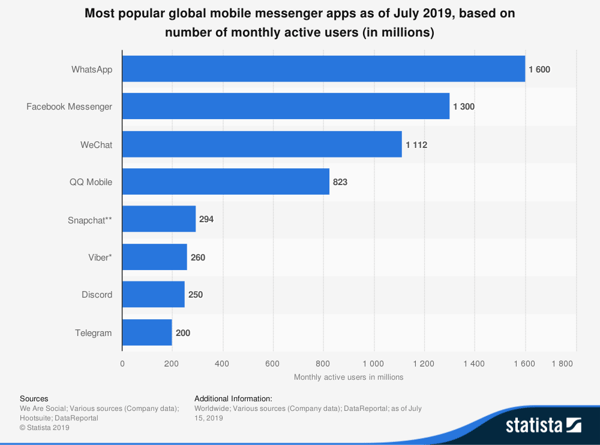
WhatsApp Stats
- WhatsApp has over two billion active users globally. (WhatsApp)
- WhatsApp for Business, an app for WhatsApp brands launched in 2019, now has 5 million users. (WhatsApp)
- By Q1 of 2018, 60 billion messages were being sent through the platform each day. (Mark Zuckerberg)
- India, Brazil, and the United States have the biggest WhatsApp audiences, with 340 million, 99 million, and 68 million users respectively. (eMarketer)
- Uruguay and Argentina are the fastest-growing WhatsApp audiences with a 67% and 63% increase in Apple App Store downloads in Q4 of 2019. (Statista)
- In 2018, WhatsApp grew its U.K. user base by 20% (We Are Social Digital Report)
- 46% of WhatsApp users are under 45 years old, with the biggest age group between 26 and 35. (Statista)
- Facebook reportedly paid 21.8 billion to acquire WhatsApp and all of its users. (Investopedia)
- WhatsApp users cumulatively spend 2 billion minutes on calls every day. (WhatsApp)
- There are only 25 countries where WhatsApp doesn't lead the messaging app market. (Messenger People)
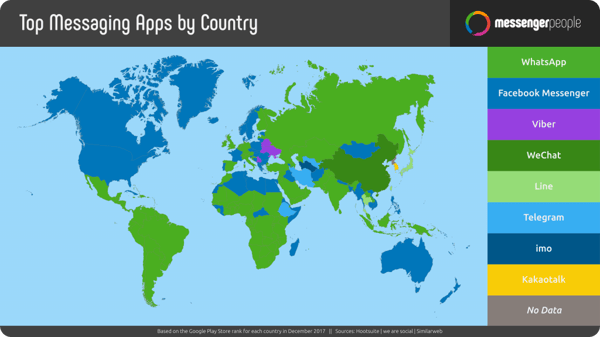
- 51% of mobile messaging app users say they prefer to contact brands via mobile messages. (Kenshoo)
- In 2018, just over 149 million people had at least one mobile messaging app on their smartphone. That number is estimated to grow to 171 million by 2022. (eMarketer)
- In the U.S., 45.5% of people were using a messaging app in 2018. (eMarketer)
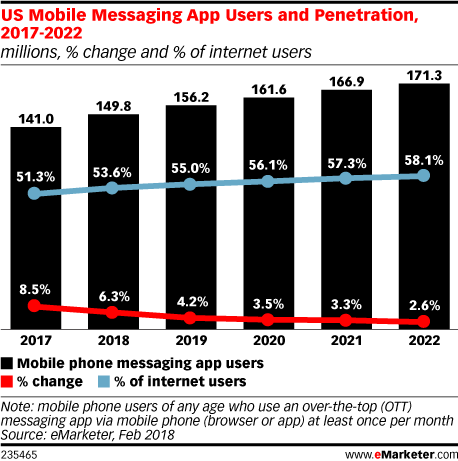
Facebook Messenger Stats
- In 2019, Facebook Messenger had over 106 million active users in the U.S. (Statista)
- The app has over 1.3 billion monthly active users globally, (Statista)
- There are more than 40 million monthly active businesses on Messenger. (Facebook)
- While WhatsApp is currently the leading messaging app, Facebook Messenger is the second most downloaded app of all time, behind Facebook. (Facebook)
- 410 million users use video chat monthly on the platform. (Facebook)
- In 2019, video chat on Messenger saw a 40% year over year growth. (Facebook)
- Brands quickly eyed Facebook Messenger as an opportunity for chatbots. By 2016, 300,000 company bots were active on this channel. (TechCrunch)
- 23-35 year-olds make up more than 27% of the Facebook Messenger user base. (Statista)
- In 2018, an average of 20 billion messages were sent via Facebook Messenger each month. (Facebook)
- When consumers message brands via Facebook, 80% of the messages ask questions about a product or service before a purchase is made. (Facebook)
- WeChat has over 1.5 billion users globally. (Statista)
- By 2021, WeChat is projected to have more than 674 million monthly active users. (eMarketer)
- Nearly 43% of WeChat users were born in the 1990s, while just over 25% of users were born in the 2000s. (ChinaChannel)
- During the Chinese New Year, 28 million people were playing WeChat games each hour. (ChinaChannel)
- The app is owned by Tencent, a China-based corporation which is the fifth-biggest company in the world. (CNN)
- In 2018, the WeChat hosted 410 million video calls. (Sina: Translated with Google Chrome)
- In 2019, 79% of Chinese internet users reported using WeChat. (We Are Social and HootSuite)
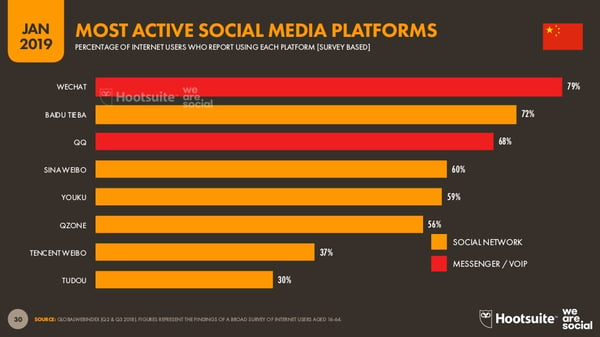
Snapchat Stats
- 38% of Snapchat users aren't on Facebook or Instagram. (Snapchat)
- Snapchat claims to have over 218 global daily active users. (Snapchat)
- 24% of U.S. adults use Snapchat (Pew Research Center)
- 53% of adult Snapchat users log on to the app at least once a day. (Pew Research Center)
- Most U.S. Snapchat users primarily use the app for conversations with friends. (Snapchat)
- 90% of 13 to 24-year-olds use Snapchat while 75% of 13 to 34-year-olds use the app. (Snapchat)
- More than 15% of the total Snaps sent daily feature a lens made by Snapchatters with the Lens Kit. (Snap Inc.)
- The longest Snapchat streak, or messages consecutively sent between two people, was 1,154 snaps. (Techjunkie)
- In 2017, 3.5 billion snaps of photos were sent on the platform. (Statista)
Navigating Messaging Apps for Marketing
As you choose an app to leverage in your messaging strategy, make sure the platform's global and age demographics are in line with your target audience. For example, while Facebook Messenger is a great tool to use if you're targeting U.S. millennials, WhatsApp might be of interest to you if you're looking to step into a global strategy.
To help you pick the right app or apps, think about your buyer persona. Where are they from? What are they most interested in? And, why would they choose to interact with your brand on a platform? As you answer these questions, you can develop a deeper understanding of which platforms and messaging strategies are right for you.
To learn more about the platforms discussed, check out these posts which highlight the marketing benefits of WhatsApp, Facebook Messenger, Snapchat, and WeChat.
Want to learn more about general messaging-based marketing strategies? Click here.
Social Media Trends



![Is Threads losing steam? Here’s what we know [new research]](https://53.fs1.hubspotusercontent-na1.net/hubfs/53/is-threads-losing-steam.png)
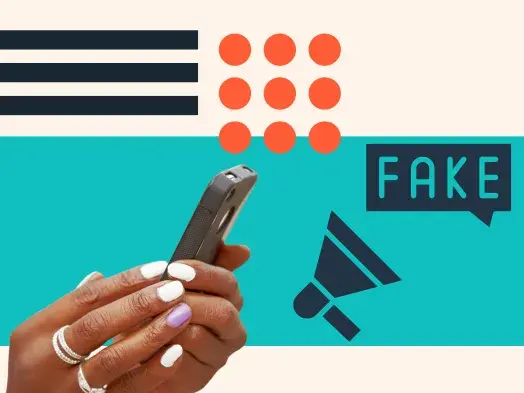

![The fastest growing social media platforms of 2025 [new data]](https://53.fs1.hubspotusercontent-na1.net/hubfs/53/fastest-growing-social-media-platforms.jpg)
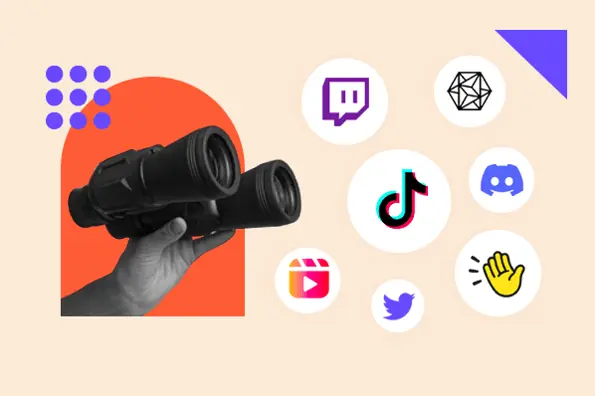
![The Future of Social Media [Research]: What Marketers Need to Know in 2025](https://53.fs1.hubspotusercontent-na1.net/hubfs/53/Future%20of%20Social%20Media.jpg)
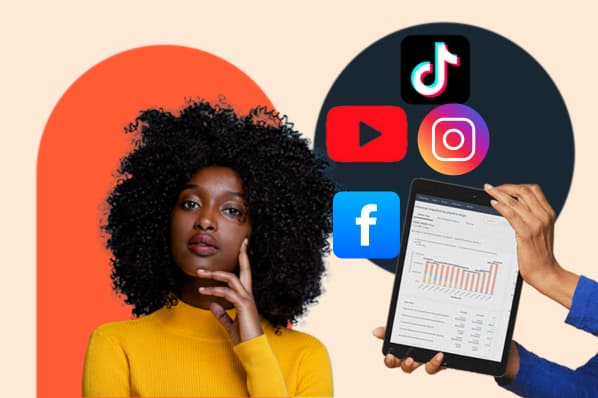
%20(1).webp)
-3.png)
